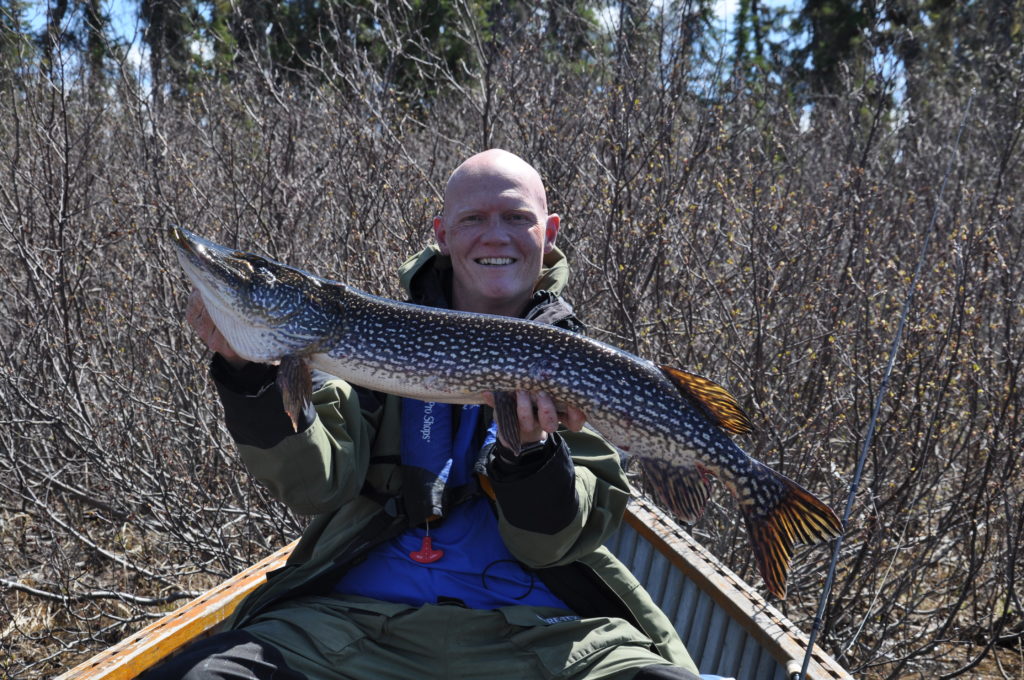 As a follow up to my first post on our Experience on the Attawapiskat, it’s now time to turn our attention to one of the two species of fish we caught, starting with Northern Pike. Our trip having taken place at the end of May, after a particularly cold / late Spring, we knew we’d have to do some exploring to find where the fish were in relation to their spawning habits, as well as use different techniques to see what would be the most effective. The water temps were low, so we were expecting that slower, more deliberate presentations would be the most effective. Rather than deep water adjacent to structure, we anticipated the fish would be not too far from their spawning grounds, meaning rivers, river mouths, and expansive flats of currents were where we’d have the most success. We were right.
As a follow up to my first post on our Experience on the Attawapiskat, it’s now time to turn our attention to one of the two species of fish we caught, starting with Northern Pike. Our trip having taken place at the end of May, after a particularly cold / late Spring, we knew we’d have to do some exploring to find where the fish were in relation to their spawning habits, as well as use different techniques to see what would be the most effective. The water temps were low, so we were expecting that slower, more deliberate presentations would be the most effective. Rather than deep water adjacent to structure, we anticipated the fish would be not too far from their spawning grounds, meaning rivers, river mouths, and expansive flats of currents were where we’d have the most success. We were right.
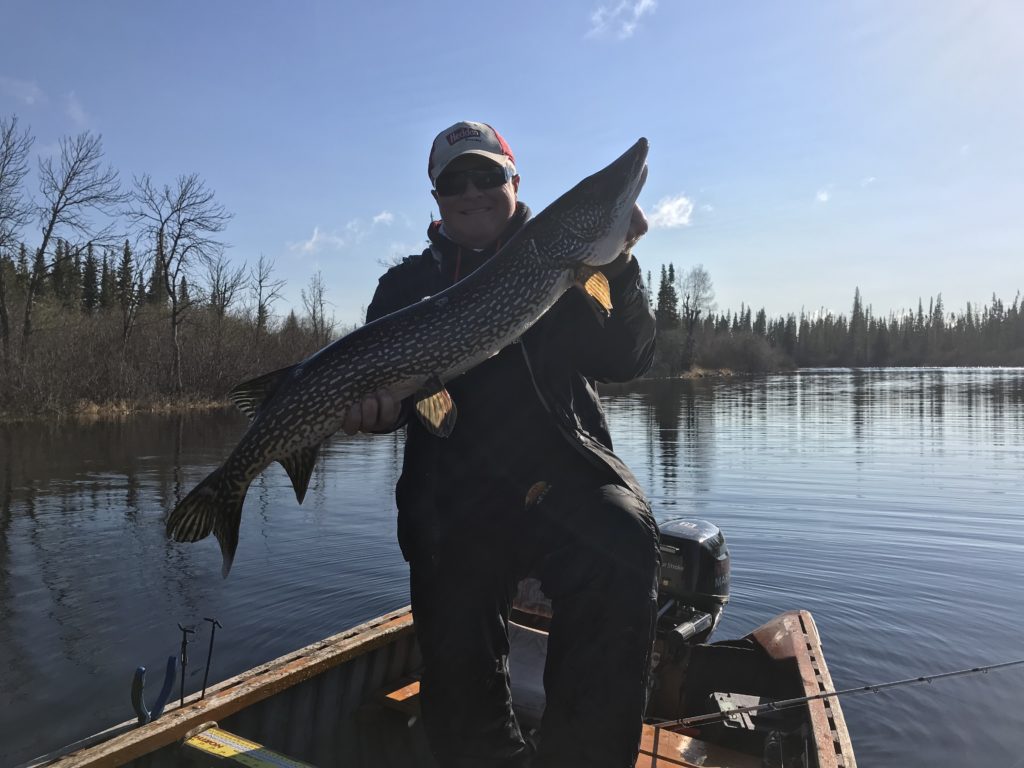 Our first day on the water was cool, a bit wet, with just the right amount of wind. I personally love fishing in cloudy and cool conditions, and a bit of wind has never hurt. On trips like these, if we are going to get rough weather, I prefer we get it at the start while our spirits are at the highest. These conditions were not harsh, and we started our our search to “see if they are biting” as our guide Norm opined. We began in small tributary off the main river, in an area that was known to hold a lot of Walleye and the occasional big Pike. This particular location we called “The Trapper Cabin”, because, well, there was a trapper cabin at the one end. We trolled that run back and fourth for a couple hours, and we caught an obscene number of Walleye. As an example, in that window I was fishing with my father, and we had double digit double headers! None of these fish were giants, but they were all in the 17-19 in class, which is plenty fun to get the week started.
Our first day on the water was cool, a bit wet, with just the right amount of wind. I personally love fishing in cloudy and cool conditions, and a bit of wind has never hurt. On trips like these, if we are going to get rough weather, I prefer we get it at the start while our spirits are at the highest. These conditions were not harsh, and we started our our search to “see if they are biting” as our guide Norm opined. We began in small tributary off the main river, in an area that was known to hold a lot of Walleye and the occasional big Pike. This particular location we called “The Trapper Cabin”, because, well, there was a trapper cabin at the one end. We trolled that run back and fourth for a couple hours, and we caught an obscene number of Walleye. As an example, in that window I was fishing with my father, and we had double digit double headers! None of these fish were giants, but they were all in the 17-19 in class, which is plenty fun to get the week started.
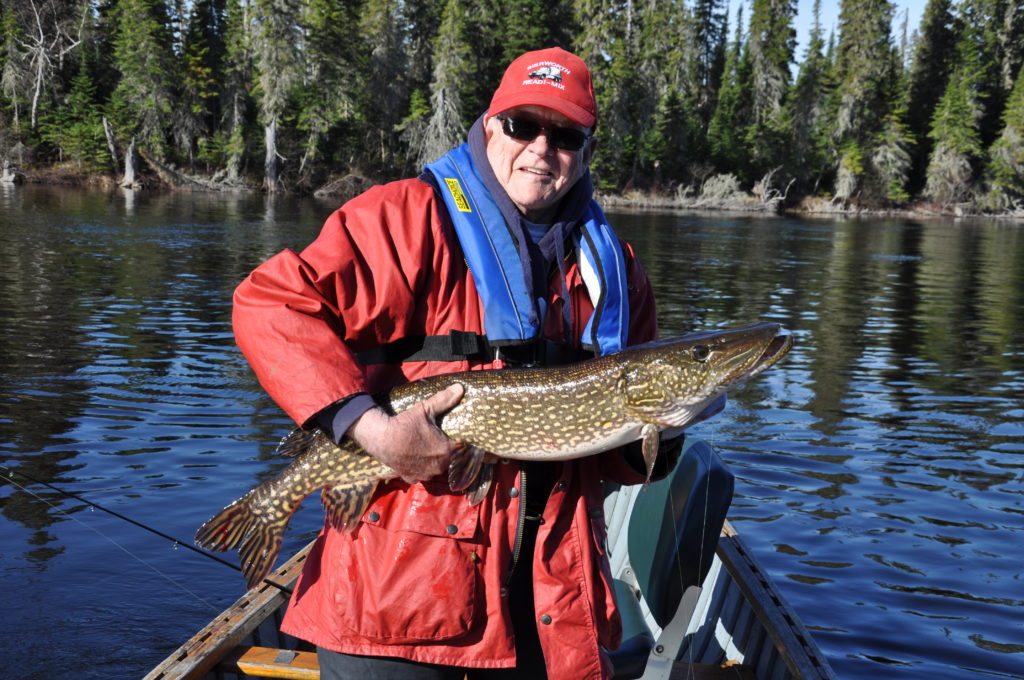 After a quick lunch we headed out for the afternoon / evening, making what would be a daily activity of “long runs” to other key areas on the river. It was sometimes challenging to be just “driving” when you could be fishing, but with Norm there to coach us along, we knew that each long run would result in exponentially better fishing potential. In this case we drove about 40 minutes to the first of two tributary rivers. In what would become a repeatable experience, we found that big Northern Pike were staged in the mouths of the rivers, where they were likely resting up after the spawn. On this particular afternoon we started by trolling up and down the tributaries, a technique I had not expected to use, let alone have it be so effective. We caught a lot of large fish. Now, to put it in perspective, our group was hoping that we’d each catch a 40 inch fish, which we determine to be somewhat of a benchmark for a trophy class fish. There is nothing wrong with the 30-34 / 35-39, but 40 was the goal.
After a quick lunch we headed out for the afternoon / evening, making what would be a daily activity of “long runs” to other key areas on the river. It was sometimes challenging to be just “driving” when you could be fishing, but with Norm there to coach us along, we knew that each long run would result in exponentially better fishing potential. In this case we drove about 40 minutes to the first of two tributary rivers. In what would become a repeatable experience, we found that big Northern Pike were staged in the mouths of the rivers, where they were likely resting up after the spawn. On this particular afternoon we started by trolling up and down the tributaries, a technique I had not expected to use, let alone have it be so effective. We caught a lot of large fish. Now, to put it in perspective, our group was hoping that we’d each catch a 40 inch fish, which we determine to be somewhat of a benchmark for a trophy class fish. There is nothing wrong with the 30-34 / 35-39, but 40 was the goal.
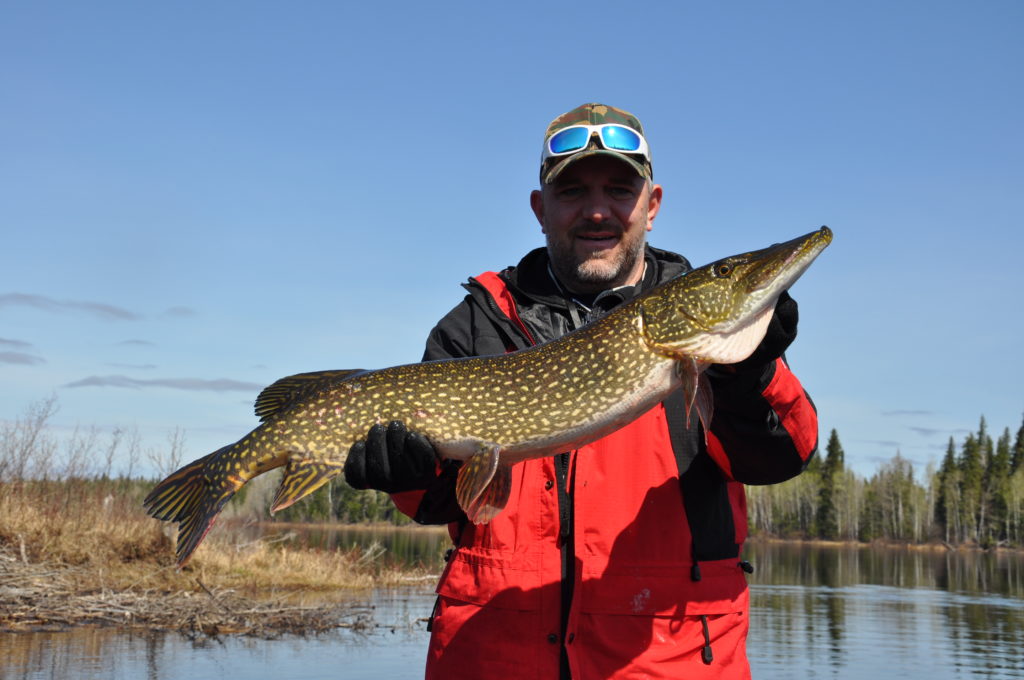 I had started trolling an orange / copper Dr. Spoon, and boated two 40s in the first hour of the afternoon! Some anglers go their whole lives not catching that size fish, and I’d already added a couple more to my personal memory bank. Having moved up stream to the base of some rapids to wait for the other boat, I threw on a Rapalal BX Minnow and boated three more fish (35/37/39) in the 30 minutes while we waited. I actually think my father was getting annoyed having to stop his own fishing to net the fish. Really, we were not even done the first day, and had already experienced some of the best fishing ever, and we were not done yet. As our pair of boats united, we navigated up the rapids, and pulled into shore, so we could fish a small pool at the base of some rapids we could not get the boats past. We spread out, finding openings in the trees to make our casts. I’ll save the details for my Walleye post, but suffice it to say, there were more casts that ended with a hungry Walleye than not! Having really put a beat down on the fish, it was time to head back home and wrap of the day with a nice meal, and some cards, talking about “what a day it had been”.
I had started trolling an orange / copper Dr. Spoon, and boated two 40s in the first hour of the afternoon! Some anglers go their whole lives not catching that size fish, and I’d already added a couple more to my personal memory bank. Having moved up stream to the base of some rapids to wait for the other boat, I threw on a Rapalal BX Minnow and boated three more fish (35/37/39) in the 30 minutes while we waited. I actually think my father was getting annoyed having to stop his own fishing to net the fish. Really, we were not even done the first day, and had already experienced some of the best fishing ever, and we were not done yet. As our pair of boats united, we navigated up the rapids, and pulled into shore, so we could fish a small pool at the base of some rapids we could not get the boats past. We spread out, finding openings in the trees to make our casts. I’ll save the details for my Walleye post, but suffice it to say, there were more casts that ended with a hungry Walleye than not! Having really put a beat down on the fish, it was time to head back home and wrap of the day with a nice meal, and some cards, talking about “what a day it had been”.
 Our subsequent days developed a comfortable rhythm of testing the bite at a spot close to the cabin, before heading out on longer runs. We would often hop our way to our final destinations, skipping over spots so we could hit them on the way back. We also left some locations for a day or two if we’d really hit them hard, to help them re-set. We were releasing all of the big fish, and wanted a crack at landing some of them a second time. The pattern continued to be consistent in that the streams and mouths consistently produced the biggest Pike, with us occasionally landing a large Northern while jigging for Walleye. What was very fun was that really, the average size fish was exceptional. Often on our fly in trips we had to weed through small fish in order to catch the occasional large one. On this trip, over 7 days, I don’t think I landed more than a couple dozen Pike that were less than 30 inches, and I landed more than that which were larger.
Our subsequent days developed a comfortable rhythm of testing the bite at a spot close to the cabin, before heading out on longer runs. We would often hop our way to our final destinations, skipping over spots so we could hit them on the way back. We also left some locations for a day or two if we’d really hit them hard, to help them re-set. We were releasing all of the big fish, and wanted a crack at landing some of them a second time. The pattern continued to be consistent in that the streams and mouths consistently produced the biggest Pike, with us occasionally landing a large Northern while jigging for Walleye. What was very fun was that really, the average size fish was exceptional. Often on our fly in trips we had to weed through small fish in order to catch the occasional large one. On this trip, over 7 days, I don’t think I landed more than a couple dozen Pike that were less than 30 inches, and I landed more than that which were larger.
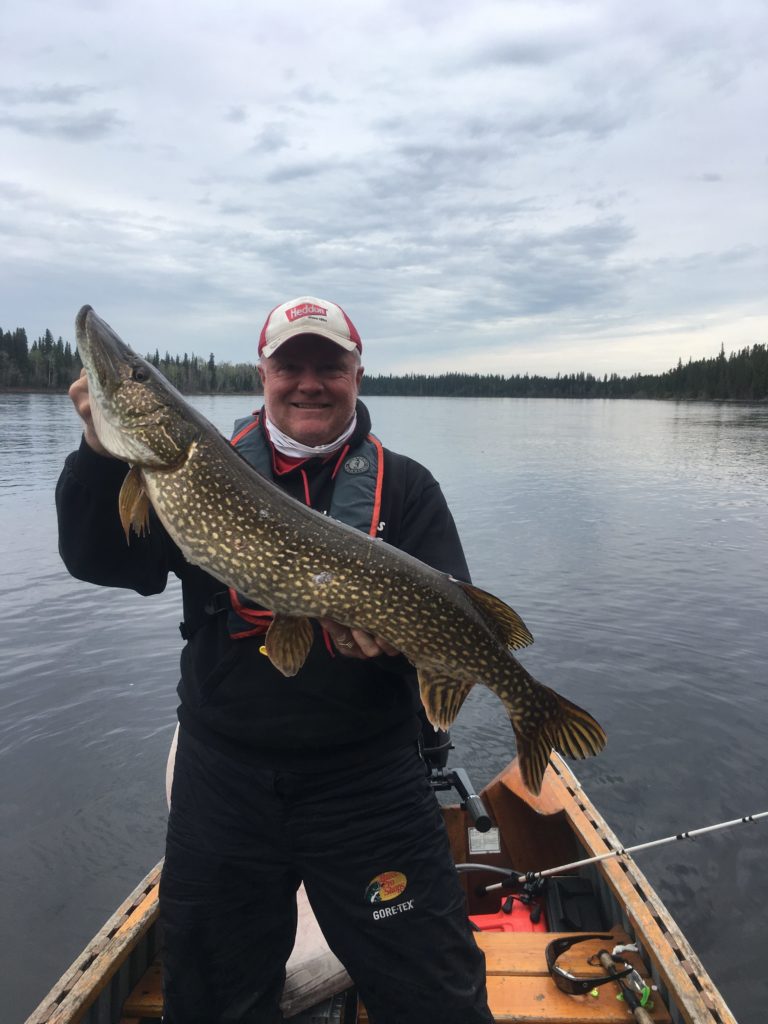 On this trip I did not keep a written log of size and number of fish by day, but between my brother and I, we can consistently recall what fish we caught, where, on what lure, etc. This has helped us develop our own pattern for what lures we are more successful with, and when to deploy them. What I do know is that I was fortunate to land three fish over 40 inches (my brother also landed a 40 plus), almost two dozen in the 35-39, and really I didn’t count the 30-34 (we literally just unhooked them and released). My most successful lures for big Pike were the Orange / Copper Dr. Spoon, a silver Williams Wabbler (70g), a perch pattern BX Minnow, and of course my 1/4oz Moon Eye Jig, usually topped with a Power Grub or B Fishn Moxi.
On this trip I did not keep a written log of size and number of fish by day, but between my brother and I, we can consistently recall what fish we caught, where, on what lure, etc. This has helped us develop our own pattern for what lures we are more successful with, and when to deploy them. What I do know is that I was fortunate to land three fish over 40 inches (my brother also landed a 40 plus), almost two dozen in the 35-39, and really I didn’t count the 30-34 (we literally just unhooked them and released). My most successful lures for big Pike were the Orange / Copper Dr. Spoon, a silver Williams Wabbler (70g), a perch pattern BX Minnow, and of course my 1/4oz Moon Eye Jig, usually topped with a Power Grub or B Fishn Moxi.
Trolling the rivers, casting the base of rapids along with river mouths, and of course casting jigs, produced our best results. The combination of current, with slack water and submerged scrub bush (because of the high water), or large flats adjacent to the moving water were the key considerations. What was also extremely helpful was to have an experienced 1st Nations River Guide to take you to they key spots, and to help decide when it was time to move on.
 Let me sum it up this way, if you want to catch a lot of really big Pike, in a part of Canada that very few will ever visit, book your trip to Pym Island with Hearst Air. If you’d like to stay informed of when I add new posts, just sign up and you’ll get a weekly email showing the latest reports. And as always, if you’d like to connect and share your stories or ask for more information on any of the places I’ve fished, just email me at scott@canadianfisherman.ca and I’ll get back to you!
Let me sum it up this way, if you want to catch a lot of really big Pike, in a part of Canada that very few will ever visit, book your trip to Pym Island with Hearst Air. If you’d like to stay informed of when I add new posts, just sign up and you’ll get a weekly email showing the latest reports. And as always, if you’d like to connect and share your stories or ask for more information on any of the places I’ve fished, just email me at scott@canadianfisherman.ca and I’ll get back to you!